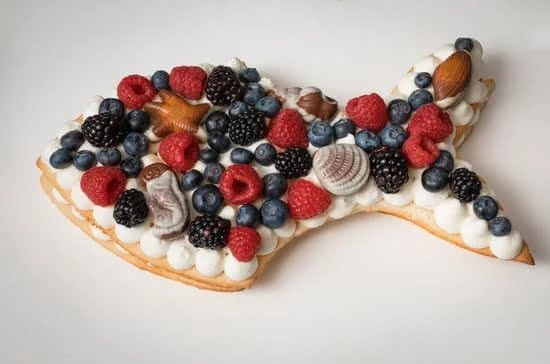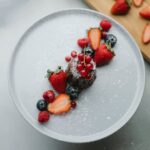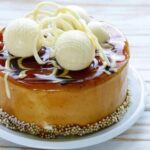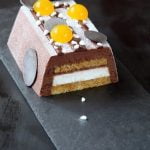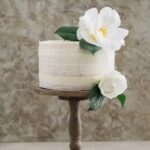Vanilla frosting is an essential component of cake decorating that has been a longstanding favorite among bakers and dessert enthusiasts alike. With its versatility and widespread popularity, it is no wonder that vanilla frosting is the go-to choice for many when it comes to adding that perfect finishing touch to their cakes.
Not only does vanilla frosting enhance the flavor of cakes, but it also plays a crucial role in elevating their visual appeal. It acts as a blank canvas upon which bakers can let their creativity run wild, transforming plain cakes into stunning works of edible art. Whether you are crafting a simple birthday cake or an elaborate wedding cake, vanilla frosting provides the ideal base for any design.
The history of vanilla frosting dates back centuries, with its traditional use rooted in early cake decorating practices. The subtle yet aromatic flavor of vanilla paired with its creamy consistency made it an immediate favorite for those looking to create delectable desserts that tantalize both the taste buds and the eyes. Today, vanilla frosting remains a classic choice for cake decorators all over the world, carrying on this rich legacy while still providing endless possibilities for customization and innovation.
Understanding the Ingredients for Vanilla Frosting
When it comes to making delicious vanilla frosting for cake decorating, understanding the key ingredients is essential. Each ingredient plays a crucial role in achieving the perfect flavor and consistency. Here is a breakdown of the essential ingredients required for making vanilla frosting:
- Butter: Butter is one of the main components of vanilla frosting and provides richness and creaminess to the mixture. It is important to use unsalted butter at room temperature for easier mixing and smoother texture.
- Powdered Sugar: Also known as confectioners’ sugar or icing sugar, powdered sugar adds sweetness and helps thicken the frosting. Sifting the powdered sugar before adding it to the mixture can help prevent lumps.
- Vanilla Extract: The star ingredient that gives vanilla frosting its delightful flavor, vanilla extract should be of high quality for optimal taste. Pure vanilla extract is recommended over artificial ones for a more authentic flavor profile.
- Heavy Cream or Milk: Liquid is needed to thin out the frosting and achieve the desired consistency. Heavy cream or milk can be used depending on personal preference and dietary restrictions.
- Salt: A small amount of salt helps balance out the sweetness of the frosting and enhances its overall flavor profile.
In addition to these basic ingredients, there are various ways to customize your vanilla frosting recipe based on taste preferences and dietary needs. For example, you can use dairy-free alternatives such as margarine or vegan butter instead of regular butter for a vegan-friendly version of vanilla frosting. Non-dairy milk can replace heavy cream or milk for lactose-intolerant individuals.
By understanding these key ingredients and their roles in creating vanilla frosting, you will be well equipped to experiment with different variations and achieve a delicious result every time you decorate a cake with this classic flavor.
Mastering the Art of Making Vanilla Frosting from Scratch
Making vanilla frosting from scratch is a rewarding experience that allows you to customize the taste and texture according to your preferences. By following a step-by-step guide and paying attention to important tips, you can achieve a homemade vanilla frosting that will elevate your cake decorating skills.
To start, gather the essential ingredients for making vanilla frosting. These typically include butter, powdered sugar, milk or cream, and vanilla extract. It is crucial to use high-quality vanilla extract for optimal flavor, as it is the star ingredient in vanilla frosting.
Next, follow these steps to make homemade vanilla frosting:
- In a mixing bowl, beat softened butter until creamy using an electric mixer.
- Gradually add powdered sugar and continue beating until well combined.
- Incorporate milk or cream gradually while mixing on low speed until desired consistency is reached.
- Finally, add a generous amount of vanilla extract and beat for an additional minute.
When making vanilla frosting, achieving the perfect texture and consistency is key. If the frosting is too thick, add more milk or cream one tablespoon at a time until it reaches the desired spreadable consistency. On the other hand, if it becomes too runny, gradually add more powdered sugar until it thickens up.
For those with dietary restrictions or preferences, there are alternative recipes available for vegan or dairy-free options. These may involve substituting butter with vegetable shortening or plant-based margarine and using non-dairy milk alternatives such as almond milk.
| Ingredient | Amount |
|---|---|
| Butter | 1 cup (226g) |
| Powdered Sugar | 4 cups (454g) |
| Milk or Cream | 1/4 cup (60ml) |
| Vanilla Extract | 2 teaspoons (10ml) |
Enhancing the Flavor of Vanilla Frosting
Vanilla frosting is already a delicious and versatile option for cake decorating, but sometimes you may want to add a little extra flavor to take it to the next level. By experimenting with different flavor variations, you can create unique and delectable combinations that will impress your friends and family. Here are some ideas for enhancing the flavor of vanilla frosting:
- Citrus Zest: Adding citrus zest, such as lemon or orange, to vanilla frosting can give it a refreshing and tangy twist. Simply grate the zest of the citrus fruit into the frosting and mix well. This addition adds brightness and complexity to the traditional vanilla flavor.
- Cocoa Powder: If you’re a chocolate lover, incorporating cocoa powder into your vanilla frosting can create a rich and decadent treat. Start by adding small amounts of unsweetened cocoa powder at a time, tasting as you go until you achieve your desired level of chocolate flavor.
- Extracts: Another way to enhance the flavor of vanilla frosting is by using different extracts. For instance, almond extract can add a subtle nutty taste, while coconut extract can give it a tropical vibe. Experiment with different extracts to find your favorite combination.
It’s important to remember that when adding additional flavors to vanilla frosting, you should balance them with the natural sweetness of vanilla. Be cautious not to overpower the delicate flavors or make the frosting too sweet. Start by adding small amounts of the desired flavors and gradually adjust according to your taste preferences.
| Flavor Variation | Instructions |
|---|---|
| Citrus Zest | Grate lemon or orange zest into vanilla frosting and mix well. |
| Cocoa Powder | Add unsweetened cocoa powder to vanilla frosting in small amounts, tasting as you go. |
| Extracts | Add a small amount of almond or coconut extract to vanilla frosting and adjust according to taste. |
Remember, these are just a few ideas to get you started. Feel free to experiment with other ingredients and flavor combinations that match your preferences. The possibilities are endless when it comes to enhancing the flavor of vanilla frosting for your cake decorating endeavors.
Decorating Techniques with Vanilla Frosting
Vanilla frosting is not only delicious, but it also serves as a versatile canvas for creating stunning cake decorations. Whether you are a beginner or an experienced baker, mastering various decorating techniques can take your cakes to the next level. Here are some tried and tested decorating techniques that work exceptionally well with vanilla frosting.
Piping Techniques
One of the most popular ways to decorate cakes with vanilla frosting is through piping techniques. Piping allows you to create intricate designs and patterns that add a professional touch to your cakes. You can use different nozzles and tools to achieve various effects.
Start with a round nozzle for basic outlines, lettering, or dots. If you want to create delicate floral designs or ruffles on your cake, switch to a petal-shaped nozzle. For more intricate details like leaves or lattice patterns, a leaf-shaped or star nozzle works best.
To pipe, fill a piping bag fitted with the desired nozzle and twist the top of the bag to secure the frosting. Apply gentle pressure on the bag while moving it in a consistent motion to create your desired design. Practice on parchment paper before piping directly onto your cake for better control and precision.
Using Different Nozzles and Tools
Besides piping techniques, there are other tools that can help you achieve professional-looking cake decorations with vanilla frosting. Spatulas, offset spatulas, and palette knives are essential for smoothing out icing surfaces or creating textured effects like ruffles.
To add dimension to your cake decorations, consider using stencils. Place a stencil directly onto the cake surface and gently dust powdered sugar or cocoa powder over it using a fine-mesh sieve. When you remove the stencil, it leaves behind a beautiful design.
Another fun way to decorate cakes with vanilla frosting is by using edible glitter or sprinkles. Simply sprinkle them over freshly frosted cakes for a glamorous and festive touch. You can also use edible flowers, fruits, or chocolate ganache to create eye-catching embellishments.
Experimenting with different tools and techniques will help you discover your own unique style when it comes to cake decorating with vanilla frosting.
Combining Techniques for Stunning Results
Remember, there are no limits to creativity when using vanilla frosting for cake decorating. You can combine various techniques to create one-of-a-kind designs that will wow your friends and family.
For example, start by using a spatula to create a smooth base layer of vanilla frosting on your cake. Then, switch to piping techniques for intricate details such as flowers or borders. Finally, add some sprinkles or other embellishments for an extra pop of color and texture.
By combining different techniques, you can achieve visually stunning cakes that are not only delicious but also a feast for the eyes.
Troubleshooting Common Issues with Vanilla Frosting
Making and working with vanilla frosting can sometimes pose challenges, even for experienced bakers. However, with a little knowledge and some helpful tips, you can overcome common issues that may arise during the process. In this section, we will discuss some of the most common problems that can occur while making or working with vanilla frosting and provide solutions to help you achieve a smooth and delicious final product.
One common issue that people encounter when making vanilla frosting is graininess. This can happen if the sugar is not properly dissolved in the butter or if powdered sugar is used instead of granulated sugar. To avoid grainy texture, make sure to beat the butter until it is creamy and smooth before gradually adding the sugar. It’s also important to use granulated sugar to allow for proper dissolving.
Air bubbles are another problem that can occur while making vanilla frosting. These air bubbles can be frustrating as they can cause uneven texture on cakes or when piping decorations. To prevent air bubbles, start by sifting your powdered sugar to remove any lumps, which could contribute to air pockets. Additionally, take care not to overbeat the frosting as this can introduce excess air into the mixture.
Sometimes, you may find that your vanilla frosting has a consistency that is too stiff to work with. If this happens, there are a few possible reasons. One reason could be that you added too much powdered sugar or liquid too quickly without properly adjusting the other ingredients.
To fix this issue, try adding a small amount of additional liquid (such as milk or cream) gradually until you reach your desired consistency. It’s important to add liquids slowly so you have control over how thin or thick your frosting becomes.
By understanding these common issues and their solutions, you’ll be better equipped to troubleshoot problems that may arise while making or working with vanilla frosting. With some practice and experimentation, you’ll be able to achieve the perfect texture and consistency for your cake decorating needs.
Creative Ideas for Cake Decorating with Vanilla Frosting
Exploring Unique Cake Decorating Ideas
Vanilla frosting provides a blank canvas for endless creative possibilities when it comes to cake decorating. Whether you’re a beginner or an experienced baker, here are some unique ideas to inspire your next cake masterpiece:
- Ombré Elegance: Create a stunning ombré effect by graduating the color of your vanilla frosting from dark to light. Start with a bold hue at the bottom and gradually add less coloring as you move towards the top of the cake. Use an offset spatula or a bench scraper to smooth the frosting and blend the colors seamlessly.
- Whimsical Watercolor: Bring out your inner artist by painting watercolor designs on your cakes using vanilla frosting as your paint palette. Thin down different shades of frosting with water or milk, and use food-safe paintbrushes to create beautiful strokes, swirls, and patterns on the cake’s surface.
- Floral Fantasy: Add an elegant touch to your vanilla frosted cake by decorating it with delicate edible flowers. Use buttercream piping techniques to create roses, daisies, or any other floral design that suits your theme. Freeze-dried flower petals can also be gently pressed into the frosting for added texture and visual appeal.
Incorporating Colors, Textures, and Embellishments
Elevate your vanilla-frosted cakes with various colors, textures, and embellishments that will make them stand out on any occasion:
- Colorful Confetti: For a festive touch, mix in colorful sprinkles or confetti into your vanilla frosting before applying it on the cake. This adds pops of color throughout each slice and adds a playful element to your creation.
- Textured Patterns: Experiment with different textures using various tools like combs or pattern presses to create unique designs on the surface of your frosted cake. This could include geometric shapes, lace-like patterns, or even textured stenciling.
- Edible Embellishments: Elevate your cake decorations with edible embellishments like gold or silver leaf, edible pearls, or delicate sugar flowers. These extra touches will add elegance and sophistication to your vanilla-frosted masterpiece.
Remember, the key to successful cake decorating is practice, persistence, and allowing yourself to let your creativity shine through. Vanilla frosting provides the perfect base to explore different techniques and ideas. So go ahead and let your imagination run wild as you create stunning cakes that are sure to impress everyone who sees them.
Sources:
- Greenfield, Laura M.D (2020) “Vanilla Frosting for Cake Decorating“. Pastry Arts Magazine.
- Powell-Hicks, Kaye (2019)”The Art of Cake Decorating”. Sterling Publishing Co., Inc.
- Williams P.L., Todd E.C., Boudreau T.F., Griffiths M.W., Kniel K.E., Salfinger Y.(Eds.) (2018) “Artisanal Cake Decorations: Unique Designs for Any Occasion”. CRC Press.
FAQs about Vanilla Frosting for Cake Decorating
Vanilla frosting is a beloved choice for cake decorating due to its versatility and delightful flavor. As you embark on your cake decorating journey, you may have some questions about vanilla frosting and its various aspects. In this section, we will answer some commonly asked questions to help you better understand and make the most out of this classic frosting flavor.
- How long does vanilla frosting last?
- Can I substitute ingredients in vanilla frosting?
- How can I adjust the sweetness of vanilla frosting?
- What if I need to make a larger quantity of vanilla frosting?
Vanilla frosting can typically be stored in an airtight container at room temperature for up to 3 days. If you need to store it for a longer period, it is best to refrigerate it. When refrigerated, vanilla frosting can last up to 1 week. Before using refrigerated frosting, allow it to come back to room temperature and give it a quick whisk or beat with an electric mixer to restore its creamy consistency.
Absolutely. Vanilla frosting allows for flexibility when it comes to ingredient substitutions. For example, if you prefer a dairy-free option, you can replace butter with margarine or vegan butter substitutes. Additionally, if you don’t have access to traditional dairy milk, you can use alternative milk options such as almond milk or coconut milk.
If you find your vanilla frosting too sweet for your liking, there are a few ways to adjust the sweetness level. You can reduce the amount of powdered sugar used in the recipe or add a pinch of salt to balance out the sweetness. Another option is to incorporate tart flavors like lemon juice or zest into the frosting mixture.
Scaling up your vanilla frosting recipe is relatively simple. Just remember that ratios are crucial when multiplying ingredients. Start by determining how much more or less frosting you need compared to your original recipe and adjust accordingly. It’s always better to make a little extra than to run short and have to make more frosting in the middle of your decorating process.
By addressing these frequently asked questions about vanilla frosting, you can be well equipped with the knowledge needed to confidently venture into cake decorating using this classic and delectable flavor. Don’t be afraid to experiment and personalize your vanilla frosting creations to create stunning cakes that will delight both the eyes and taste buds.
Conclusion
In conclusion, vanilla frosting is truly a magical ingredient when it comes to cake decorating. Its versatility and popularity make it an ideal choice for enhancing the flavor and appearance of cakes. Whether you are a beginner or an experienced baker, understanding the ingredients and mastering the art of making vanilla frosting from scratch can open up a world of creativity in your cake decorations.
By carefully selecting high-quality vanilla extract and using the right ingredients, you can achieve the perfect texture and consistency for your vanilla frosting. Experimenting with different flavor variations, such as adding citrus zest or extracts like almond or coconut, can take your frosting to another level. It is important to balance these added flavors with the natural sweetness of vanilla to create a harmonious taste.
When it comes to decorating techniques, there are endless possibilities with vanilla frosting. Piping intricate designs and patterns using various nozzles can help create professional-looking decorations. Troubleshooting common issues, such as graininess or too stiff consistency, ensures that you have a smooth and beautiful frosting every time.
To unleash your creativity, explore unique cake decorating ideas and incorporate different colors, textures, and embellishments into your designs. Whether you are looking to make a birthday cake or a wedding masterpiece, vanilla frosting provides the perfect foundation for all your decorative visions.
Frequently Asked Questions
What kind of frosting is best for decorating cakes?
When it comes to decorating cakes, the best kind of frosting is buttercream frosting. Buttercream frosting is versatile and can be easily tinted with food coloring to create vibrant shades for decorations. It has a smooth texture that is suitable for spreading and piping onto cakes, allowing for intricate designs and details.
Additionally, buttercream frosting can hold its shape well, making it ideal for creating piped flowers, borders, and other decorative elements on cakes. Its creamy taste pairs well with various cake flavors, making it a popular choice for cake decorators.
Will vanilla frosting harden?
Vanilla frosting typically does not harden in the same way that royal icing does. While it may firm up slightly as it sets on a cake or cupcakes, vanilla frosting tends to remain soft and creamy even after being applied to baked goods.
This makes it easy to cut through or bite into without any excessive hardness. However, if you refrigerate vanilla frosting or allow it to chill for an extended period, it will become firmer but still maintain its creamy consistency rather than hardening like royal icing.
What’s the difference between frosting and vanilla icing?
Frosting and vanilla icing are terms often used interchangeably in everyday conversation, but there are some subtle differences between the two. Frosting generally refers to a thick and fluffy mixture used as a topping or filling for cakes and pastries. It is made by combining fat (such as butter or shortening) with powdered sugar along with other ingredients like flavorings (such as vanilla extract), milk or cream to achieve a spreadable consistency.
On the other hand, vanilla icing is usually thought of as a thinner glaze-like coating that covers the surface of baked goods. It typically contains fewer ingredients compared to frosting – mainly powdered sugar mixed with milk or water for fluidity and vanilla extract for flavoring – resulting in a smoother but less substantial layer on top of sweet treats like cookies or cinnamon rolls.

Welcome to our cake decorating blog! My name is Destiny Flores, and I am the proud owner of a cake decorating business named Cake Karma. Our mission is to provide delicious, beautiful cakes for all occasions. We specialize in creating custom cakes that are tailored specifically to each customer’s individual needs and tastes.

